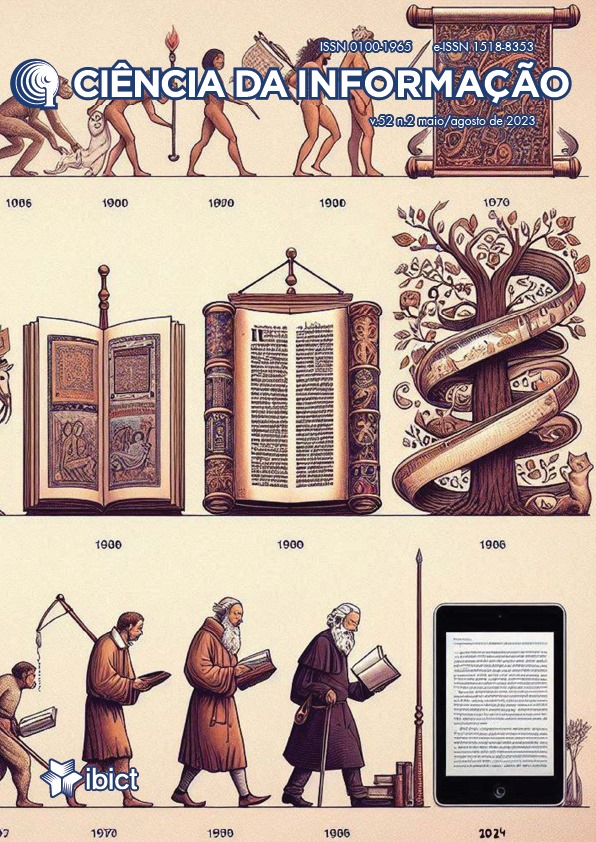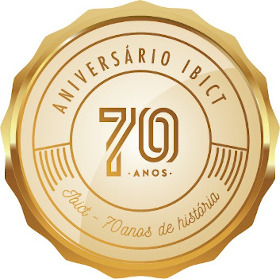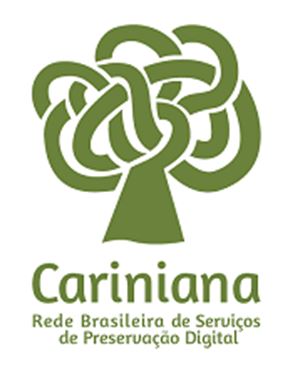Digital transformation in the public sphere: abibliometric analysis
DOI:
https://doi.org/10.18225/ci.inf.v52i2.7099Palavras-chave:
e-governance, information technology governance, bibliometric analysisResumo
This study addresses the significant impact of technology on the growth and prominence of contemporary organizations, examining the relationship between digital transformation and business sustainability. The research highlights the importance of digital adaptations to maintain relevance in the global market. The main focus is on conducting a bibliometric analysis of digital transformation, identifying emerging themes that contribute to the valorization of organizations. The adopted methodology consists of a literature review, using the Scopus database and tools such as VOSviewer and Gephi for network analysis of keyword co- occurrence, co-citation of cited references, bibliographic coupling of documents, and identification of emerging trends. Additionally, content analysis is employed for a more detailed examination of the identified themes. The results indicate that the effectiveness of digital transformation in an organization is intrinsically linked to its level of maturity in electronic governance. Furthermore, it is evident that the adoption of an IT governance framework is crucial for a successful implementation of digital transformation.
Downloads
Referências
ALALWAN, A. A.; BAABDULLAH, A. M.; DWIVEDI, Y. K.; RANA, N. P.; LAL, B. RAMAN, R. Et-moone and marketing relationship governance: the effect of digital transformation and ICT during the COVID-19 pandemic. Industrial Marketing Management, Bradford, n. 98, p. 241–254, 2021.
ALENIZI, A. S.; AL-KARAWI, K. A. Cloud Computing Adoption-Based Digital Open Government Services: Challenges and Barriers. Lecture Notes in Networks and Systems, [s. l.], n. 216, p. 149–160, 2022.
ALLEN, B.; TAMINDAEL, L. E.; BICKERTON, S. H.; CHO, W. Does citizen coproduction lead to better urban services in smart cities projects? An empirical study on e-participation in a mobile big data platform. Government Information Quarterly, [s. l.], v. 37, n. 1, p. 101412, Jan. 2020.
ANDERSEN, K. V.; HENRIKSEN, H. Z. E-government maturity models: Extension of the Layne and Lee model. Government Information Quarterly, Copenhage, v. 23, n. 2, p. 236–248, 2006.
ANWAR, M.; JOSHI, J.; TAN, J. Anytime, anywhere access to secure, privacy-aware healthcare services: Issues, approaches and challenges. Health Policy and Technology, [s. l.], v. 4, n. 4, p. 299–311, 2015.
BASTIAN, M.; HEYMANN, S.; JACOMY, M. Gephi: an open source software for exploring and manipulating networks. Proceedings of the International AAAI Conference on Web and Social Media, [s. l.], v. 3, n. 1, p. 361-362, 2009. DOI: 10.1609/icwsm.v3i1.13937.
BERTOT, J. C.; JAEGER, P. T.; GRIMES, J. M. Using ICTs to create a culture of transparency: E-government and social media as openness and anti-corruption tools for societies. Government Information Quarterly, Washington, v. 27, n. 3, p. 264–271, 2010.
BLONDEL, V. D.; GUILLAUME, J.-L.; LAMBIOTTE, R.; LEFEBVRE, E. Fast unfolding of communities in large networks. Journal of Statistical Mechanics: theory and experiment, [s. l.], v. 2008, n. 10, p. P10008, 2008.
BORGATTI, S. P.; EVERETT, M. G.; FREEMAN, L. C. Ucinet 6 for Windows: software for social network analysis. Connections, Harvard, v. 15, n. 1/2, 2002.
BÖRNER, K.; CHEN, C.; BOYACK, K. W. Visualizing knowledge domains. In: Annual review of information science and technology, v. 45, n. 1, p. 179–255, Jan. 2003.
CALLON, M.; COURTIAL, J. P.; TURNER, W. A.; BAUIN, S. From translations to problematic networks: an introduction to co-word analysis. Social Science Information, [s. l.], v. 22, n. 2, p. 191–235, 1983.
CAMARGO, B. V.; JUSTO, A. M. IRAMUTEQ: um software gratuito para análise de dados textuais. Temas em Psicologia, [s. l.], v. 21, n. 2, p. 513-518, 2013.
CHATFIELD, A. T.; REDDICK, C. G. Understanding Risk Communication Gaps through E-Government Website and Twitter Hashtag Content Analyses: the case of Indonesia’s Mt. Sinabung Eruption. Journal of Homeland Security and Emergency Management, Wollongong, v. 12, n. 2, p. 351–385, 2015.
CHATFIELD, A. T.; REDDICK, C. G. Smart City Implementation Through Shared Vision of Social Innovation for Environmental Sustainability: a case study of Kitakyushu, Japan. Social Science Computer Review, [s. l.], v. 34, n. 6, p. 757–773, 2016.
COURSEY, D.; NORRIS, D. F. Models of E-Government: are they correct? an empirical assessment. Public Administration Review, [s. l.], v. 68, n. 3, p. 523–536, 2008.
DEJA, M.; RAK, D.; BELL, B. Digital transformation readiness: perspectives on academia and library outcomes in information literacy. Journal of Academic Librarianship, [s. l.], v. 47, n. 5, 2021.
DWIVEDI, Y. K.; HUGHES, D. L.; COOMBS, C.; CONSTANTIOU, J.; DUAN, Y.; EDWARDS, J. S.; GUPTA, B.; LAL, B.; MISRA, S.; PRASHANT, P.; RAMAN, R.; RANA, N. P.; SHARMA, S. K.; UPADHYAY, N. Impact of COVID-19 pandemic on information management research and practice: transforming education, work and life. International Journal of Information Management, [s. l.], n. 55, p. 102211, 2020.
EBRAHIM, Z.; IRANI, Z. E‐government adoption: architecture and barriers. Business Process Management Journal, [s. l.], v. 11, n. 5, p. 589–611, 2005. DOI: 10.1108/14637150510619902.
ELGAZZAR, Y.; EL-SHAHAWY, R.; SENOUSY, Y. The Role of Digital Transformation in Enhancing Business Resilience with Pandemic of COVID-19. In: Magdi, D.A., Helmy, Y.K., Mamdouh, M., Joshi, A. (ed.). Digital Transformation Technology. Lecture Notes in Networks and Systems. Singapore: Springer, 2022. v. 224. p. 323–333. DOI: 10.1007/978-981-16-2275-5_20.
ELLEGAARD, O.; WALLIN, J. A. The bibliometric analysis of scholarly production: How great is the impact? Scientometrics, [s. l.], v. 105, n. 3, p. 1809–1831, 2015.
EVANS, D.; YEN, D. C. E-Government: evolving relationship of citizens and government, domestic, and international development. Government Information Quarterly, [s. l.], v. 23, n. 2, p. 207–235, 2006. DOI: 10.1016/j.giq.2005.11.004.
GARCÍA-PEÑALVO, F. J.; CORELL, A.; ABELLA-GARCÍA, V.; GRANDE, M. Online assessment in higher education in the time of COVID-19. Education in the Knowledge Society, [s. l.], v. 19, p. 12-1/12-26, 2020. DOI: https://doi.org/10.14201/eks.23013.
GARFIELD, J.; AHLGREN, A. Difficulties in learning basic concepts in probability and statistics: implications for research. Journal for Research in Mathematics Education, [s. l.], v. 19, n. 1, p. 44–63, 1988. DOI: http://dx.doi.org/10.2307/749110.
GLÄNZEL, W.; THIJS, B. Using ‘core documents’ for detecting and labelling new emerging topics. Scientometrics, [s. l.], v. 91, n. 2, p. 399–416, 2011. DOI: https://doi.org/10.1007/s11192-011-0591-7.
GÖKALP, E.; ŞENER, U.; EREN, P. E. Development of an assessment model for industry 4.0: Industry 4.0-MM. Communications in Computer and Information Science, [s. l.], n. 770, p. 128–142, 2017. DOI: 10.1007/978-3-319-67383-7_10.
GREGORY, R. W.; KAGANER, E.; HENFRIDSSON, O.; RUCH, T. J. It consumerization and the transformation of it governance. MIS Quarterly: Management Information Systems, [s. l.], v. 42, n. 4, p. 1225–1253, 2018. DOI: 10.25300/MISQ/2018/13703.
GRUCHMANN, T.; BISCHOFF, O. Blockchain-driven handling of digital freight information: A tensions perspective. Logistics Research, [s. l.], v. 14, n. 3, p. 1-16, 2021. DOI: 10.23773/2021_3. GUNDUZ, M. A.; DEMIR, S.; PAKSOY, T. Matching functions of supply chain management with smart and sustainable Tools: a novel hybrid BWM-QFD based method. Computers and Industrial Engineering, [s. l.], v. 162, p. 107676, 2021. DOI: https://doi.org/10.1016/j.cie.2021.107676.
HAN, H.; TRIMI, S. Towards a data science platform for improving SME collaboration through Industry 4.0 technologies. Technological Forecasting and Social Change, [s. l.], v. 174, p. 121242, Jan. 2022. DOI: https://doi.org/10.1016/j.techfore.2021.121242.
HARRISON, T. M.; GUERRERO, S.; BURKE, G. B.; COOK, M. E., CRESSWELL, A. M.; HELBIG, N.; HRDINOV, J.; PARDO, T. A. Open government and e-government: Democratic challenges from a public value perspective. Information Polity, [s. l.], v. 17, n. 2, p. 83–97, 2012.
HEEKS, R.; BAILUR, S. Analyzing e-government research: perspectives, philosophies, theories, methods, and practice. Government Information Quarterly, Manchester, v. 24, n. 2, p. 243–265, 2007.
HOFMANN, P.; SAMP, C.; URBACH, N. Robotic process automation. Electronic Markets, [s. l.], v. 30, n. 1, p. 99–106, 2020. DOI: 10.1007/s12525-019-00365-8.
HOGNOGI, G.-G.; POP, A.-M.; MARIAN-POTRA, A.-C.; SOMEȘFĂLEAN, T. The role of UAS–GIS in digital Era governance: a systematic literature review. Sustainability, Switzerland, v. 13, n. 19, 2021. DOI: https://doi.org/10.3390/su131911097.
JANSSEN, M.; HELBIG, N. Innovating and changing the policy-cycle: policy-makers be prepared! Government Information Quarterly, [s. l.], v. 35, n. 4, p. S99–S105, 2018. DOI: https://doi.org/10.1016/j.giq.2015.11.009. Supplement.
KAMALALDIN, A.; LINDE, L.; SJÖDIN, D.; PARIDA, V. Transforming provider-customer relationships in digital servitization: a relational view on digitalization. Industrial Marketing Management, [s. l.], v. 89, p. 306–325, 2020. DOI: https://doi.org/10.1016/j.indmarman.2020.02.004.
KAPPELMAN, L.; JOHNSON, V.; TORRES, R.; MAURER, C.; MCLEAN, E. A study of information systems issues, practices, and leadership in Europe. European Journal of Information Systems, [s. l.], v. 28, n. 1, p. 26–42, 2019. DOI: 10.1080/0960085X.2018.1497929.
KESSLER, M. M. Bibliographic coupling between scientific papers. American Documentation, [s. l.], v. 14, n. 1, p. 10–25, 1963. DOI: https://doi.org/10.1002/.
KOHLI, R.; JOHNSON, S. Digital transformation in latecomer industries: CIO and CEO leadership lessons from Encana Oil & Gas (USA) Inc. MIS Quarterly Executive, [s. l.], v. 10, n. 4, p. 141–156, 2011.
KÜCHER, A.; FELDBAUER-DURSTMÜLLER, B. Organizational failure and decline: a bibliometric study of the scientific frontend. Journal of Business Research, [s. l.], n. 98, p. 503–516, 2019. DOI: 10.1016/j.jbusres.2018.05.017.
KYRYCHENKO, M.; YAKUBOVSKIY, S.; RODIONOVA, T. Digital Transformation of the Oil Refining Sector in Ukraine. In: 2020 IEEE International Conference on Problems of Info communications, 2020, Kharkiv. Conference […]. Kharkiv: IEEE. 2020. p. 733-736. DOI: 10.1109/PICST51311.2020.9468064.
LAUFER, M.; LEISER, A.; DEACON, B.; BRICHAMBAUT, P. P.; FECHER, B.; KOBSDA, C.; HESSE F. Digital higher education: a divider or bridge builder? Leadership perspectives on edtech in a COVID-19 reality. International Journal of Educational Technology in Higher Education, [s. l.], v. 18, n. 1, 2021. DOI: 10.1186/s41239-021-00287-6.
LAYNE, K.; LEE, J. Developing fully functional E-government: a four stage model. Government Information Quarterly, [s. l.], v. 18, n. 2, p. 122–136, 2001.
LEÃO, P.; SILVA, M. M. Impacts of digital transformation on firms’ competitive advantages: a systematic literature review. Strategic Change, [s. l.], v. 30, n. 5, p. 421–441, 2021. DOI: 10.1002/jsc.2459.
LEE, J. 10 year retrospect on stage models of e-Government: a qualitative meta-synthesis. Government Information Quarterly, [s. l.], v. 27, n. 3, p. 220–230, 2010. DOI: 10.1016/j.giq.2009.12.009.
LEE-GEILLER, S.; LEE, T. D. Using government websites to enhance democratic E-governance: a conceptual model for evaluation. Government Information Quarterly, [s. l.], v. 36, n. 2, p. 208–225, 2019. DOI: 10.1016/j.giq.2019.01.003.
LINDERS, D.; LIAO, C. Z.-P.; WANG, C.-M. Proactive e-Governance: flipping the service delivery model from pull to push in Taiwan. Government Information Quarterly, [s. l.], v. 35, n. 4, p. S68–S76, 2018. Supplement. DOI: 10.1016/j.giq.2015.08.004.
LOUBÈRE, L.; RATINAUD, P. Documentation IRaMuTeQ. [S. l.]: IRaMuTeQ, 2014. Available at: http://www.iramuteq.org/documentation/fichiers/documentation_19_02_2014.pdf. Access on: 5 set. 2021.
MARCHE, S.; MCNIVEN, J. D. E-government and e-governance: the future isn’t what it used to be. Canadian Journal of Administrative Sciences, [s. l.], v. 20, n. 1, p. 74–86, 2003. DOI: 10.1111/j.1936-4490.2003.tb00306.x.
MARTINEZ-BALLESTE, A.; PEREZ-MARTINEZ, P.; SOLANAS, A. The pursuit of citizens’ privacy: a privacy-aware smart city is possible. IEEE Communications Magazine, [s. l.], v. 51, n. 6, p. 136–141, 2013.
MCCAIN, K. W. Communication, competition, and secrecy: the production and dissemination of research-related information in genetics. Science, Technology, & Human Values, [s. l.], v. 16, n. 4, p. 491–516, 1991. DOI: 10.1177/016224399101600404.
MCCAIN, N. L.; LYNN, M. R. Meta-Analysis of a Narrative Review: studies evaluating patient teaching. Western Journal of Nursing Research, [s. l.], v. 12, n. 3, p. 347–358, 1990.
MCNUTT, J. G.; JUSTICE, J. B.; MELITSKI, J. M.; AHN, M. J.; SIDDIQUI, S. R.; CARTER, D. T.; Kline, A. D. The diffusion of civic technology and open government in the United States. Information Polity, [s. l.], v. 21, n. 2, p. 153–170, 2016.
MOON, M. J. The Evolution of E-Government among Municipalities: Rhetoric or Reality? Public Administration Review, [s. l.], v. 62, n. 4, p. 424–433, July/Aug. 2002.
MORESI, E. A. D.; PINHO, I. Proposta de abordagem para refinamento de pesquisa bibliográfica. New Trends in Qualitative Research, Portugal, v. 9, p. 11–20, 2021. DOI: 10.36367/ntqr.9.2021.11-20.
MORESI, E. A. D., PINHO, I., Costa, A. P. How to operate literature review through qualitative and quantitative analysis integration? IN: COSTA, A. P., MOREIRA, A., SÁNCHEZ GÓMEZ, M. C., WA-MBALEKA, S. (ed.). Computer Supported Qualitative Research WCQR 2022. Lecture Notes in Networks and Systems. [S. l.]: Springer, n. 466, p. 194-210.
NEWMAN, M. Networks: an introduction. Oxford: Oxford University Press, 2009.
NEWMAN, Y. C.; AGYIN-BIRIKORANG, S.; ADJEI, M. B.; SCHOLBERG, M. L.; SILVEIRA, J. M. B.; VENDRAMINI, J. E.; RECHCIGL, L. E.; SOLLENBERGER, CHRYSOSTOME, M. Enhancing Phosphorus Phytoremedation Potential of Two Warm-Season Perennial Grasses with Nitrogen Fertilization. Agronomy Journal, [s. l.], v. 101, n. 6, p. 1345–1351, 2009.
NIELSEN, M. M. E-governance and stage models: analysis of identified models and selected Eurasian experiences in digitising citizen service delivery. Electronic Government, an International Journal, [s. l.], v. 12, n. 2, p. 107–141, 2016.
PASADEOS, Y.; PHELPS, J.; KIM, B.-H. Disciplinary Impact of Advertising Scholars: temporal comparisons of influential authors, works and research networks. Journal of Advertising, [s. l.], v. 27, n. 4, p. 53–70, 1998.
PEREIRA, G. V.; PARYCEK, P.; FALCO, E.; KLEINHANS, R. Smart governance in the context of smart cities: a literature review. Information Polity, [s. l.], v. 23, n. 2, p. 143–162, 2018. DOI: 10.3233/IP-170067.
PRITCHARD, R. D. Equity theory: A review and critique. Organizational Behavior and Human Performance, [s. l.], v. 4, n. 2, p. 176–211, 1969. DOI: 10.1016/0030-5073(69)90005-1.
PIZZI, S.; VENTURELLI, A.; VARIALE, M.; MACARIO, G. P. Assessing the impacts of digital transformation on internal auditing: A bibliometric analysis. Technology in Society, v. 67, 101738, 2021.
RAGHURAM, S.; TUERTSCHER, P.; GARUD, R. Research Note: mapping the field of virtual work - a cocitation analysis. Information Systems Research, [s. l.], v. 21, n. 4, p. 983–999, 2010. DOI: https://doi.org/10.1287/isre.1080.0227.
RANGANATHAN, C.; TEO, T. S. H.; DHALIWAL, J. Web-enabled supply chain management: Key antecedents and performance impacts. International Journal of Information Management, [s. l.], v. 31, n. 6, p. 533–545, 2011.
REDDICK, C. G.; CHATFIELD, A. T.; JARAMILLO, P. A. Public opinion on National Security Agency surveillance programs: a multi-method approach. Government Information Quarterly, [s. l.], v. 32, n. 2, p. 129–141, Apr. 2015.
ROY, J. E-government in Canada: transformation for the digital age. Ottawa: University of Ottawa Press, 2006.
RUHNAU, B. Eigenvector-centrality: a node-centrality? Social Networks, [s. l.], v. 22, n. 4, p. 357–365, 2000.
SANDOVAL-ALMAZAN, R.; GIL-GARCIA, J. R. Are government internet portals evolving towards more interaction, participation, and collaboration? Revisiting the rhetoric of e-government among municipalities. Government Information Quarterly, [s. l.], v. 29, p. S72–S81, Jan. 2012. Supplemet 1.
SANDVIK, K. B. The Norwegian COVID-19 Tracing App Experiment: lessons for governance and civic activism. IEEE Technology and Society Magazine, [s. l.], v. 40, n. 3, p. 66–73, 2021.
SAXENA, K. B. C. Towards excellence in e-governance. International Journal of Public Sector Management, [s. l.], v. 18, n. 6, p. 498–513, 2005. DOI 10.1108/09513550510616733.
SHARMA, R.; MISHRA, R.; MISHRA, A. Determinants of satisfaction among social entrepreneurs in e-Government services. International Journal of Information Management, [s. l.], v. 60, p. 102386, Oct. 2021. DOI: https://doi.org/10.1016/j.ijinfomgt.2021.102386
SMALL, G. W.; RABINS, P. V.; BARRY, P. P.; BUCKHOLTZ, N. S.; DEKOSKY, S. T.; FERRIS, S. H.; FINKEL, S. I.; GWYTHER, L. P.; KHACHATURIAN, Z. S.; LEBOWITZ, B. D.; MCRAE, T. D.; MORRIS, J. C.; OAKLEY, F.; SCHNEIDER, L. S.; STREIM, J. E.; SUNDERLAND, T.; TERI, L. A.; TUNE, E. L. Diagnosis and Treatment of Alzheimer Disease and Related Disorders: consensus statement of the American Association for Geriatric Psychiatry, the Alzheimer’s Association, and the American Geriatrics Society. JAMA, [s. l.], v. 278, n. 16, p. 1363–1371, 1997.
SMALL, H. Co-citation in the scientific literature: a new measure of the relationship between two documents. Journal of the American Society for Information Science, [s. l.], v. 24, n. 4, p. 265–269, July/Aug. 1973.
SMALL, H.; GRIFFITH, B. C. The Structure of Scientific Literatures I: identifying and graphing specialties. Science Studies, [s. l.], v. 4, n. 1, p. 17-40, 1974.
SOUSSAN, T.; TROVATI, M. Sentiment urgency emotion conversion over time for business intelligence. International Journal of Web Information Systems, [s. l.], v. 16, n. 5, p. 519-528, Oct. 2020. DOI: https://doi.org/10.1108/IJWIS-08-2020-0049.
SU, R.; OBRENOVIC, B.; DU, J.; GODINIC, D.; KHUDAYKULOV, A. COVID-19 Pandemic Implications for Corporate Sustainability and Society: A Literature Review. International Journal of Environmental Research and Public Health, [s. l.], v. 19, p. 1-23, Jan. 2022. DOI: https://doi.org/10.3390/ijerph19031592.
TABAR, S.; SHARMA, S.; VOLKMAN, D.; LEE, H. Analyzing the network readiness index in the United States to assess ICT infrastructure in handling crises like COVID-19. International Journal of Electronic Government Research (IJEGR), [s. l.], v. 17, n. 4, p. 1–14, 2021. DOI: 10.4018/IJEGR.2021100101.
TANGI, L.; JANSSEN, M.; BENEDETTI, M.; NOCI, G. Digital government transformation: a structural equation modelling analysis of driving and impeding factors. International Journal of Information Management, [s. l.], v. 60, p. 102356, 2021. DOI: https://doi.org/10.1016/j.ijinfomgt.2021.102356.
TEO, T. S. H.; SRIVASTAVA, S. C.; JIANG, L. Trust and electronic government success: an empirical study. Journal of Management Information Systems, [s. l.], v. 25, n. 3, p. 99–132, 2008.
THOMAS, J. C.; STREIB, G. The new face of government: citizen-initiated contacts in the era of E-Government. Journal of Public Administration Research and Theory, [s. l.], v. 13, n. 1, p. 83–102, 2003.
ÜSDIKEN, B.; PASADEOS, Y. Organizational Analysis in North America and Europe: a comparison of co-citation networks. Organization Studies, [s. l.], v. 16, n. 3, p. 503–526, 1995.
VAN ECK, N. J.; WALTMAN, L. Visualizing bibliometric networks. In: Ding, Y., Rousseau, R., Wolfram, D. (eds.). Measuring scholarly impact: methods and practice. New York: Springer, 2014. p 285–320.
VAN ECK, N. J.; WALTMAN, L. VOSviewer manual. Leiden: Universiteit Leiden, 2022.
WALTMAN, L.; VAN ECK, N. J.; NOYONS, E. C. M. A unified approach to mapping and clustering of bibliometric networks. Journal of Informetrics, [s. l.], v. 4, n. 4, p. 629-635, Out. 2010.
WEERAKKODY, V.; JANSSEN, M.; DWIVEDI, Y. K. Transformational change and business process reengineering (BPR): lessons from the British and Dutch public sector. Government Information Quarterly, [s. l.], v. 28, n. 3, p. 320–328, July. 2011.
WEST, D. M. E-Government and the Transformation of Service Delivery and Citizen Attitudes. Public Administration Review, [s. l.], v. 64, n. 1, p. 15–27, Feb. 2004.
WHITE, M. D.; MARSH, E. E. Content analysis: a flexible methodology. Library Trends, [s. l.], v. 55, n. 1, p. 22-45, 2006.
WHITE, H. D.; MCCAIN, K. W. Visualizing a discipline: an author co-citation analysis of information science, 1972–1995. Journal of the American Society for Information Science, [s. l.], v. 49, n. 4, p. 327–355, 1998.
YILDIZ, M. E-government research: reviewing the literature, limitations, and ways forward. Government Information Quarterly, [s. l.], v. 24, n. 3, p. 646–665, July. 2007.
YUCEL, S. Estimating the benefits, drawbacks and risk of digital transformation strategy. In: 2018 International Conference on Computational Science and Computational Intelligence (CSCI), 2018, Las Vegas. Anais […]. Las Vegas: IEEE, 2008. p. 233-238.
YURKEVICH, E. V.; STEPANOVSKAYA, I. A.; KRYUKOVA, L. N. Mechanisms of Information Support for the Digital Transformation of Space Complexes Based on the Concept of Socio-cyber-physical Self-organization. In: Proceedings of the Fifth International Scientific Conference “Intelligent Information Technologies for Industry” (IITI’21). [S. l.]: Springer Link, 2022, v. 330, p. 629-637. DOI: https://doi.org/10.1007/978-3-030-87178-9_62.
ZENG, Z.; LI, S.; LIAN, J.-W.; ZENG, Z.; LI, S.; LIAN, J.-W.; LI, J., CHEN, T., LI, Y. Switching behavior in the adoption of a land information system in China: a perspective of the push–pull–mooring framework. Land Use Policy, [s. l.], v. 109, Oct. p. 2021.
ZUPIC, I.; ČATER, T. Bibliometric methods in management and organization. Organizational Research Methods, [s. l.], v. 18, n. 3, p. 429–472, 2015.
Downloads
Publicado
Edição
Seção
Licença
Copyright (c) 2024 Eduardo Amadeu Dutra Moresi, Wanderson Aparecido da Silva Alves, Ana Paula Bernardi da Silva, Helga Cristina Hedler

Este trabalho está licenciado sob uma licença Creative Commons Attribution-ShareAlike 4.0 International License.
- A publicação se reserva o direito de efetuar, nos originais, alterações de ordem normativa, ortográfica e gramatical, com vistas a manter o padrão culto da língua, respeitando, porém, o estilo dos autores;
- As provas finais não serão enviadas aos autores;
- Os autores mantém os direitos totais sobre seus trabalhos publicados na revista Ciência da Informação, ficando sua reimpressão total ou parcial, depósito ou republicação sujeita à indicação de primeira publicação na revista, por meio da Licença Pública 4.0 Internacional Atribuição-CompartilharIgual
- Deve ser consignada a fonte de publicação original;
- As opiniões emitidas pelos autores dos artigos são de sua exclusiva responsabilidade;
- Cada autor receberá dois exemplares da revista, caso esteja disponível no formato impresso.





























